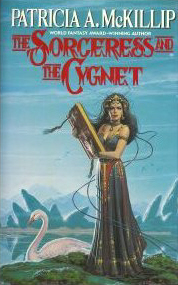A review of Patricia A. McKillip’s The Sorceress and the Cygnet
 Corleu is an oddity, a white-haired youth in a black-haired tribe of wanderers. His family has a talent for foresight, but all he has is a knack for stories. And then one year the tribe goes south for the winter and finds itself in a marsh where time seems to stand still, where the flowers are perfect but the skies are invisible behind the mists — and no one knows how long they’ve been there. No one but Corleu notices anything wrong.
Corleu is an oddity, a white-haired youth in a black-haired tribe of wanderers. His family has a talent for foresight, but all he has is a knack for stories. And then one year the tribe goes south for the winter and finds itself in a marsh where time seems to stand still, where the flowers are perfect but the skies are invisible behind the mists — and no one knows how long they’ve been there. No one but Corleu notices anything wrong.
Then things get really surreal.
If you like your magic as a form of exotic science, with clearly delineated cause and effect — the sort of worldbuilding Brandon Sanderson does, for instance — The Sorceress and the Cygnet is probably not the book for you. Little is explained, least of all the magic system.
The plot revolves around five beings whose nature is never entirely defined. They could be gods, although they’re never worshipped. They could be stories come to life. They have titles rather than names. They’re represented in the heraldry and the constellations.
They seem extremely powerful, but four of them have apparently been trapped by the fifth, the being called the Cygnet. One of those four — the Gold King, who reads like a sun god or a death god or both — tricks Corleu into a quest to find the Cygnet’s heart.
It’s a puzzle that inevitably brings Corleu in contact with the other trapped beings, and just as inevitably frees them. All of the human characters, including Corleu, think that disrupting the natural order like this is probably a bad idea, but the consequences are ill-defined.
Despite the way the plot sounds when outlined, the story isn’t a standard quest narrative. For the middle third of the book, the action shifts from Corleu to a woman named Meguet, hereditary protector of the family Ro, who rule the area — country? Continent? Once again, it isn’t specified — and have a deep connection with the Cygnet.
McKillip does a good job of suggesting a deep, strange history for the Ro family without actually telling the reader much. There’s a wizard and a war, far in the past, and rumors that the house can travel mysteriously. There’s a gatekeeper who was apparently born with the instincts for his job, and a maze, and a library full of magic. Since the Gold King and his fellows arrive at Ro Holding almost as soon as Corleu frees them, some of these secrets have to be unraveled, but not all of them.
This book has no clear antagonists. The titular sorceress is the most amoral of the human cast, and she helps Corleu throughout. The ultimate stakes are personal rather than world-shaking. I enjoyed this book, but as a dreamlike flow of vivid description rather than an adrenaline-filled adventure.
If you like lush scenery, poetic style, and little snippets of imagery that stick in the mind, The Sorceress and the Cygnet is an excellent book. Just be prepared to leave some questions unanswered.
Patricia A. McKillip’s The Sorceress and the Cygnet was published in hardcover by Ace Books in 1991. The sequel, The Cygnet and the Firebird, appeared in 1993 (hardcover, Ace Books), and Ace assembled both into a single omnibus, Cygnet, in 2007.
Isabel Pelech is the author of “The Wine-Dark Sea,” from Black Gate 14.
Covert art by Romas Kukalis.
[…] My daughter-in-law, Isabel Pelech, has signed on as a reviewer for Black Gate, a publisher of fantasy literature. Her first review is up here. […]
[…] Isabel Pelech is the author of “The Wine-Dark Sea,” from Black Gate 14. Her last review for us was Patricia A. McKillip’s The Sorceress and the Cygnet […]